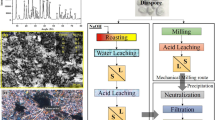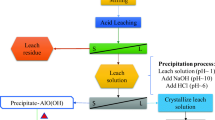Abstract
Mechano-milling is a process where materials are ball-milled at high energy to induce chemical and physical reactions. This study investigated the effect of milling on the properties and agronomic effectiveness of six apatite rock phosphates (RP). The effects of milling were evaluated by X-ray diffraction, BET-N2 surface area measurements, electron microscopy and solubility in 2% citric acid. Milling increased the solubility of RPs by increasing the proportion of X-ray amorphous material and reducing the size of remaining apatite crystals. However, milling also caused agglomeration of particles, which reduced the surface area. Milling increased the unit-cell a dimension of apatite, possibly due in part to the formation of low reactive fluorapatite such as occurs during calcination. These changes induced by mechano-milling might be expected to reduce the solubility of RPs; however, solubility increased because amorphisation was dominant. The fertiliser relative effectiveness of RPs based on phosphorus content of wheat plants was increased by a factor of up to three by milling. It is concluded that beneficiation of apatitic RPs by mechano-milling may greatly improve their agronomic effectiveness and milling may provide an economically and environmentally superior option for the manufacture of phosphate fertilisers and enable the utilisation of impure RPs.
Similar content being viewed by others
References
Association of Official Agricultural Chemists 1991. Official Methods of Analysis Vol. 1. 15th edn. AOAC, Washington, DC, pp. 16-17.
Bolland M.D.A. and Gilkes R.J. 1990. The poor performance of rock phosphate fertilisers in Western Australia: Part 2. The soil chemical explanations. Agric. Sci. 3: 44-47.
Bolland M.D.A. and Bowden J.W. 1984. The initial and residual value for subterranean clover of phosphorus from crandallite rock phosphate, apatite rock phosphates and superphosphates. Fert. Res. 5: 295-307.
Bolland M.D.A., Weatherly A.J., Gilkes R.J. and Bowden J.W. 1986. Granular reactive apatite rock phosphate is not an effective phosphorus fertilizer in the short term on lateritic soils in southside, western Australia. Aust. J. Exp. Agric. 26: 217-225.
Brady P.V. and House W.A. 1996. Surface-controlled dissolution and growth of minerals. In: Brady P.V. (ed.), Physics and Chemisand try of Mineral Surfaces. CRC Press, Inc., Boca Raton, Florida, p. 231.
Brunauer S., Emmett P.H. and Teller E. 1938. Adsorption of gasses in multimolecular layers. J. Am. Chem. Soc. 60: 309-319.
Chien S.H. and Hammond L.L. 1978. A comparison of various laboratory methods for predicting the agronomic potential of phosphate rocks for direct application. Soil Sci. Soc. Am. J. 42: 935-939.
Cooke G.W. 1975. Fertilizing for Maximum Yield. 2nd edn. Fletcher & Sons, Norwich, UK, p. 54.
Engelstad O.P., Jugsujinda A. and De Datta S.K. 1974. Response by flooded rice to phosphate rocks varying in citrate solubility. Sci. Soc. Am. Proc. 38: 524-529.
Fergus.F., Gilkes R.J. and White R.E. 1970. Calcined Duchess rock phosphate as a phosphate fertilizer. Aust. J. Sci. 32: 405-407.
Ghosh A.K. and Gilkes R.J. 1987. The initial and residual ag-ronomic effectiveness of some Indian, USA and Australian rock phosphates. Fert. Res. 12: 201-218.
Hammond L.L. 1978. Agronomic measurements of phosphate rock effectiveness. Seminar on Phosphate Rock for Direct Application. IFDC, Haifa, Israel, pp. 147-173.
Hughes J.C. and Gilkes R.J. 1994. The dissolution of North Carolina phosphate rocks in some south-western Australian soils. Fert. Res. 38: 249-253.
JCPDS 1983. Mineral powder diffraction file: group data book. International Centre for Diffraction Data, Newtown Square, Pennsylvania.
Kanabo I.A.K. and Gilkes R.J. 1988. The effect of particle size on North Carolina phosphate rock on its dissolution in soil and on levels of bicarbonate-soluble phosphorus. Fert. Res. 15: 137-145.
Kasai E., Mimura H., Sugiyama K., Saito F., Akiba K. and Waseda Y. 1994. Mechano-chemical changes in natural and synthetic zeolites by dry grinding using a planetary ball mill. Adv. Powder Technol. 5: 189-203.
Klug H.P. and Alexander L.E. 1954. X-ray Diffraction Procedures for Polycrystalline and Amorphous Materials. John Wiley & Sons, Inc., New York.
Kosanovic C., Cizmek A., Subotic G., Smit I., Stubicar M. and Tonejc A. 1995. Mechanochemistry of zeolites: Part 3. Amorphization of zeolite ZSM-5 by ball milling. Zeolites 15: 51-57.
Lim H.H. and Gilkes R.J. 2001. Beneficiation of apatite rock phosphates by calcination: adverse effects on chemical properties Methand fertiliser effectiveness. Aust. J. Soil Res. 39: 397-402.
Mackay A.D., Syers J.K. and Gregg P.E.H. 1984. A glasshouse comparison of six phosphate fertilisers. NZ J. Exp. Agric. 12: 131-140.
McClellan G.H. and Gremillion L.R. 1980. Evaluation of phosphate raw materials. In: Khasawneh F.E. et al. (eds), The Role of Phosphorus in Agriculture. American Society of Agronomy, Madison, Wisconsin, pp. 43-79.
McCormick P.G. 1995. Application of mechanical alloying to chemical refining (overview). Mater. Trans., JIM 36: 161-169.
Northcote K.H. 1971. A Factual Key for the Recognition of Australian Soils. 3rd edn. Rellim technical publications, Glensouthside, South Australia.
Novak G.A. and Colville A.A. 1989. A practical interactive least squares cell-parameter program using an electronic spreadsheet Chemisand a personal computer. Am. Min. 74: 488-490.
Palmer B. 1980. A Chemical, Mineralogical and Biological Evaluation of Calcined Christmas Island C-grade Rock Phosphate, Ph.D. Thesis, The University of Western Australia.
Singh B. and Gilkes R.J. 1992. XPAS: An interactive program to analyse X-ray powder diffraction patterns. Powder Diffrac. 1: 6-10.
Schaffer G.B. and McCormick P.G. 1991. Anomalous combustion effects during mechanical alloying. Metall. Trans. A 22: 3019- 3024.
Schaffer G.B. and McCormick P.G. 1992a. On the kinetics of mechanical alloying. Metall. Trans. A 23: 1285-1290.
Schaffer G.B. and McCormick P.G. 1992b. Mechanical alloying (review). Mater. Sci. Forum 16: 91-97.
Soil Survey Staff 1987. Keys to soil taxonomy (third printing): SMSS Technical Monograph No 6. Soil Survey Staff, Ithaca, New York.
Van Kauwenbergh S.J. 2001. Mineralogy and characterization of phosphate rock for direct application. Proceedings of the International Meeting on Direct Application of Phosphate Rock and Related Technology: Latest Developments and Practical Experiences, Kuala Lumpur, Malaysia. July 16-20, 2001.
Author information
Authors and Affiliations
Rights and permissions
About this article
Cite this article
Lim, H., Gilkes, R. & McCormick, P. Beneficiation of rock phosphate fertilisers by mechano-milling. Nutrient Cycling in Agroecosystems 67, 177–186 (2003). https://doi.org/10.1023/A:1025505315247
Issue Date:
DOI: https://doi.org/10.1023/A:1025505315247




